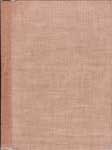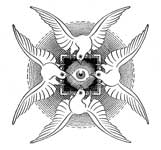The Silver Stallion
A Note on the Mirrors and Pigeons
Here’s a slightly revised version of a post I made to the Caermaen (Arthur Machen) Discussion Group after someone there asked about the “mystery of the mirror and the pigeons” as it appears in The Cream of the Jest and several other Cabell books. The other fella had seen in some index or other that James Blish (famous sci-fi writer and one-time editor of the Cabell studies journal “Kalki”) had written an article in Kalki called “The Mirror and the Pigeons Resolved”. I dug out my copies of Kalki and compiled the following history of the treatment of this “mystery” in the pages of that Cabellian journal over the years. And at the end I offer a summation.
--------------------------------------------------- -
 Kalki II. 4a (8a) 1968. p. 97
Kalki II. 4a (8a) 1968. p. 97
The Mirror and the Pigeons Resolved. By James Blish (slightly abridged)
~~~~~~~~~~~~~~~~~~~~~~~~~~~ ~
“The Last chapter of Warren a McNeill’s CABELLIAN HARMONICS (Random House, 1928) is devoted… to the mystery of the mirror and the white pigeons, which probably has baffled every reader of the Biography. McNeill asked Cabell to explain. JBC, of course, sensibly refused.
In tackling the problem, McNeill drew together and reprinted all the pertinent references, a highly useful exercise in itself. Some of his assembled clues are, as it turns out, simply accidents of association, but there are a number which are real. They are as follows:
1. The mirror is square.
2. The ritual involves the blood of white pigeons.
3. The mirror is (or can be) made of metal.
4. The ritual involves six words of power and wisdom… which were known to Solomon and a seventh which Solomon did not know.
5. The mirror is associated with the Hidden Children.
Having assembled this, and a good deal more which does not turn out to be relevant, McNeill is unable to draw any definite conclusion. I believe, however, that the problem is soluble by reference to any of several magical compilations; the following account is drawn largely from the “Grimorum Verum”…
The process is a method for composing something called “the Mirror of Solomon,” in which “ye shall behold… all things whatsoever that ye may desire.” The operator is instructed to take a shining and well-polished plate of fine steel, slightly concave, and inscribe four names at the four corners of this with the blood of a white pigeon. The steel is then placed in a clean white cloth… At the proper time, four spells follow.
Not four but seven words of power are involved. The grimoire’s text mentions only those to be written on the mirror. However, an illustration in another text shows that a fifth word must be written on the pedestal of the mirror, and that the mirror must be flanked by two candles, the bases of each of them inscribed. Thus, the total is seven, just as Cabell’s count requires. Now, why was one of these words unknown to Solomon? Simply because in each of the known accounts of the process there is one word which is not common to the others. Finally, the illustration is important because it shows the mirror to be square, though this could have been deduced… from the polishing instructions.
After these directions are followed, the angel Anael will arise after 45 (or 14) days “under the form of a beautiful child,” Thereafter it is necessary only to perfume the mirror and perform one invocation, and Anael will return for further divination.
If this attribution seems desperately banal to the reader, I can assure him that I quite agree. Even as magic, this is one of the most minor of processes. The true marvel lies in what Cabell has made of such unpromising material, almost entirely by implication.”
(various tasty excerpts from McNeill’s discussion can be seen by searching “pigeons” in the Googlebooks preview of Cabellian Harmonics)
----------------------------------------------------------------------------------------- -
 Kalki III. 3 (11) Summer 1969.
Kalki III. 3 (11) Summer 1969.
pp.88-91. “Another Mirror for Pigeons” by Emmett Peter Jr
This article discusses the various appearances of the M+P in Cabell, and usefully lists them (Storisende pagination): The Silver Stallion p.60; Jurgen pp.34, 41, 125-6; Something About Eve pp. 201, 299; Cream of the Jest pp. 78-81, 98-101, 230; Straws & Prayer-Books p.62; Special Delivery pp. 187-212
Peter’s suggestion is that Cabell derived the M+P from two stories in Sir Richard Burton’s translation of The Thousand Nights and a Night’ -- the story of the deceitful virgin Hayat al-Nufus (Medina edition Vol III, p.289) and the Djinn King’s Story (Medina edition Vol XIII p 25ff). In these tales pigeon’s blood is used to simulate the bleeding of a virgin bride, and the mirror to predict the chastity of a princess, both of which Peter connects to Jurgen’s dalliance with Guinevere, who is soon to wed King Arthur. He also points out that the Medina edition of Burton was in Cabell’s library.
pp. 112-13 “Pigeons and Poictesme”
McNeill and Blish discuss Blish’s article, agreeing that the matter is still up in the air and that “Resolved” in Blish’s title should have been followed by a question mark.
----------------------------------------------------------------- -
 Kalki IV. 3 (15) pp.107-8. “Edward and Pigeons” by James Allan
Kalki IV. 3 (15) pp.107-8. “Edward and Pigeons” by James Allan
In the second part of this note Allan points out the proto M+P in “Concerning Corrina” (a story from The Certain Hour, which preceded The Cream of the Jest).
“… a crystal of Venice Glass three inches square… Sir Thomas (Browne) reflectively scraped the edge of the glass with his fingernail… Yes, that is a bloodstain here…”
Allan feels that the connection of this with the mirror and pigeons of Cream of the Jest and later books is “obvious” but thinks that discrepancies between its form in Corinna and in the Mirror of Solomon ritual suggests that Cabell had other sources as well.
------------------------------------------------------------ -
 Kalki VI.2 (22) 1974, pp.63-67 “Cabell’s Mirrors (and incidentally) Pigeons” by W. L. Godshalk (who succeeded Blish as editor of Kalki).
Kalki VI.2 (22) 1974, pp.63-67 “Cabell’s Mirrors (and incidentally) Pigeons” by W. L. Godshalk (who succeeded Blish as editor of Kalki).
Godshalk surveys the uses of mirrors by Borges, Lewis Carroll, A. Merritt, Lawrence Durrell; and by Cabell in other contexts in Something About Eve and The Silver Stallion; and argues that assigning a single meaning and source to Cabell’s mirrors (and pigeons) is reductionist. However, he suggests that Merlin’s mirror in Jurgen (which is accompanied by the mention of pigeons and clearly connects with the Cream of the Jest M+P) is in part derived from Merlin’s mirror in Spenser’s Faerie Queen.
---------------------------------------------------------------- -
 Kalki VI.3 (23) 1974, pp. 99-110 “Reflections as to Mirrors and Pigeons” by Warren A. McNeil
Kalki VI.3 (23) 1974, pp. 99-110 “Reflections as to Mirrors and Pigeons” by Warren A. McNeil
This is a reprint of the chapter from Cabellian Harmonics (1928) in which McNeill recounts his conversations with Cabell regarding the M+P, canvases their occurrences in the Cabell canon, and offers his opinions on the subject.
---------------------------------------------------------------------- -
 Kalki 25 (1975) (This issue begins with a memorial page to the lately deceased James Blish.)
Kalki 25 (1975) (This issue begins with a memorial page to the lately deceased James Blish.)
pp.23-4. Letter “From the Author of Cabellian Harmonics”
Warren McNeill writes to Kalki editor Godshalk discussing the M+P, and states, “The personal search which intrigued me, but never reached a conclusion, was as to Cabell’s starting point in all this. Could have been from Masonic ritual, the Rosicrucians, black magic, or where? He (Cabell) gave me the teasing clue that I could find the answer in Bishop Percy’s “Reliques,” but I found nothing there…”
pp. 25-26. “Some Notes on Sources” by R. Brzustowicz, Jr.
“… one of the more persistently noticed minor mysteries in the Biography is the matter of the mirror and white pigeons, and the Venice glass of Herrick’s magic in “Concerning Corinna”. The usual solution is to refer the curious to Waite’s account of the Mirror of Solomon— but that is scarcely the most likely source, nor, historically, the most appropriate, especially with respect to Herrick. During and after the Elizabethan period there are many records of lore about the evocation of female fairies, often combined with the use of scrying crystals…. Most interesting, though, is a process taken from one of the Ashmolean MSS and given in Percy’s “Reliques, as part of a note to ‘The Fairies Farewell’:
‘An excellent way to gett a Fayrie… First, gett a broad square christall or Venice glass, in length and breadth 3 inches. Then lay that glass of christall in the bloud of a white henne, 3 Wednesdays, or 3 Fridays…’ [the whole passage may most easily be seen here at Googlebooks: http://tinyurl.com/jgtghrr (In an Editor’s note Godshalk informs us that the work quoted is “The Relation of Dr John Dee’s Actions with Spirits” (1659) ]
------------------------------------------------------------ -
Summation
It appears to me that Cabell, as he all but told McNeill, came across the “Venice glass and white hen” passage in Percy, and used it in "Concerning Corinna". But it seems likely that later (or even earlier) he also encountered the vaguely similar texts of the Mirror of Solomon and conflated them with the Percy, since the ritual as hinted at (though never performed) in the later books contains Solomonic details not present in the Percy text. On the other hand, the fact that the Cabellian version of the ritual calls for three pigeons seems to recall the Percy texts requirement for white hen blood to be used on "3 Wednesdays or 3 Fridays" -- no number of pigeons seems to be mentioned in the Solomonic texts.
